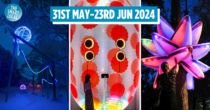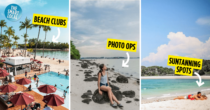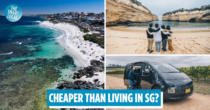Very often, I encounter friends and acquaintances asking during their overseas trips “how can I shoot pictures like those in postcards?” or “how can i shoot better pictures?” I hope to share some tips through this guide, in as “human” language as possible. I will be featuring pictures shot using a compact camera, in my case, the Canon Powershot G12. No worries if you don’t own a DSLR with a multitude of lenses, nowadays taking good pictures has become a possibility for everyone!
Compact Cameras & SLRs
Modern day compact cameras, particularly prosumer models like for e.g Canon G15 / G1X, Nikon P7700 , Sony RX-100, Fuji F900 EXR, just to name a few, are advanced compacts offering a fair amount of manual controls and advanced features. These cameras offer users excellent performance in a compact body. This is a far cry from the film days of Single Lens Reflex (SLR) cameras which were really heavy and cumbersome.
I recall during my 90s trip to Europe, where I carried 2 Minolta ( it became Konica Minolta, now Sony) SLRs with motordrives (8 AA alkaline batteries each) , 7 lens from 17mm (super wide angle) to 200mm (telephoto), flash, filters , tripod and yes… 35 rolls of Kodak. Now, I shudder to even think about the weight… and the fortunes spent on processing and printing the 3Rs or 4Rs prints after those overseas trips.
My Canon G12…. my favourite compact workhorse 🙂
8 tips for better travel photos
——————————
Tip 1: Bring your camera everywhere.
..and be ready. As the saying goes…”the best camera is the one with you”. Your camera, however high-end, will be redundant in your hotel safe box… just like an airplane in the hangar or a ship in the dock. In any case, compacts are as what they are termed… compact. You can leave your passport in the safe, but not your camera (^__^) .
Tip 2: Know your camera well.
…at least the most frequently used functions. Some camera manufacturers like Canon, gives free camera orientation clinics when you purchase their products. Such fruitful sharing session with trained in-house technicians or photographers lets you know your camera functions faster and enables you to better enjoy the built in features. Too busy to attend those workshops? You could check out camera review websites like DPreviews for a better understanding.
For readers who are not sure the relationship between ISO, shutter speed and aperture.. you might to check this useful simulator site.
Tip 3: Observe things around you.
Be a “culture vulture”, “plugged in” to the adventure… see the foreground, background, lighting which changes with the time of day. I always believe to convey beauty, you need to feel and see the beauty first. Composing the picture should also take note of the “rules of thirds”. Avoid positioning your subject in the centre… like this picture I shot in Halong Bay. The placement of the boat to the right implies the direction and journey ahead…. positioning the boat to the centre or left would have undermined the quality of the shot.
Tip 4: Make your pictures “move”.
One of the surest ways to convey fun is to allow a bit of motion blur – speeding tuk-tuks, the “frantic” marching of office workers as they walked into subway, moving trains, etc are ideal subjects. Selecting a Shutter speed bias mode (TV) or Manual mode (M) is the ideal way to achieve this. Brace yourself against a wall to avoid camera shake, support your arms on railings, keep the camera closed to your body and shoot at 1/15 sec or slower to get a sense of motion.
The trick to this technique – called Panning, is to pivot on your hip as you lock on and follow the subject as you press the shutter release. Some camera models have build in neutral density (ND) filter to reduce shutter speeds in bright daylight. Faster subjects like speeding F1 sports car require faster shutter speed between 1/125-1/250 for better subject sharpness. Combine this with lowest ISO possible for the best result. For longer exposures, a tripod would be recommended.
Panning during day – 1/60s, F9, ISO 400.
Panning at night – 1/3s, F2.8, ISO 400
Tip 5: Have Patience.
Patience is the difference between a good and great picture – you’ll often need observe the changing environment e.g – for that boat to come into your line of sight or for the ideal person to stroll past a certain spot, etc. Pre-focus on the spot that you envisioned in your mind…. get ready … be ready…. you have that one chance.
In this picture of a boat I shot on the Neva river, in St.Petersburg, Russia. I had observed the river activities. I liked the feeling of strength evoked by the bridge named Peter the Great. But it was a Saturday morning and very little activity on the river. I spotted a boat in the distance, prepared myself, cam ready, waiting….then the boat came…. snap! I had just one chance…
Tip 6: Go low…
Get a different angle.Many shutterbugs tend to shoot at chest level, as it is. A great angle would be for you to go low. You can see the usual scene gaining a sense of depth and freshness. But do not do it where ladies are wearing skirts though, as you may wade into serious trouble.
In this picture of a temple in Angkor Wat, Cambodia, the reflection of the temple on the puddle formed from just ended drizzle gave me the opportunity to shoot reflection…I hold my camera just inches from the puddle, taking care to shoot the temple at slightly brighter compensate for the bright skies. In the post edit, I desaturated the colour to make it black & white for a more dramatic feel. You can easily use your picture manager for this desaturation but my favourite free picture edit software Picasa, can be downloaded with loads of functions.
Tip 7: “Humanize” your pictures.
Do at all possible situation, rather than tourists, feature local people. Folks in their daily business, walking their pets, playing with their children,…or just being themselves. Select a choice spot, observe and be ready. Situations are dynamic and ever changing…something will surely emerge and unfold for you to capture in that fleeting moment.
This human element invariably spices up your images. In this picture of a busy street on Old Quarters, Hanoi, I observed the locals making extreme FULL use of their scooter. Often overloaded beyond breaking point… I knew had to capture this…as this would never happen in our country…(I think)…
Tip 8: Get Closer.
Robert Capa, a famous photographer once famously said, “If your pictures aren’t good enough, you’re not close enough.” Taken literally, the closer you get to your subject, the more detail and interest you can capture. That’s when your optical zoom in your camera comes into play. Notice I mentioned “optical” zoom. Optical zoom refer to the zooming via the optics of the camera while “digital” zoom is essentially in-camera processed image.
In nutshell, optic zoom gives much better pic quality than digital zoom. In this picture of a Russian of a lady police cadet in Moscow, Russia, taken their Victory Parade (National Day to us)… I had to zoom in to frame her up close for a better angle as she was some 10m away and I could not go move closer without someone usurping over my prime spot.
Last Words…
So, there you have it… 8 tips that I wished would help in some ways to readers to achieve better travel pics. And of course, here 1 last tip…enjoy your trip. It shows in your pictures…. Bon voyage (^____^)// …..
I’ll like to conclude this guide with 1 last picture of myself with my Russian friend (Oleg, extreme right) and host (Vladimir, third from right) in Tobolsk, Siberia, Russia. On my left is Timothy, an ex-colleague.

Drop us your email so you won't miss the latest news.








